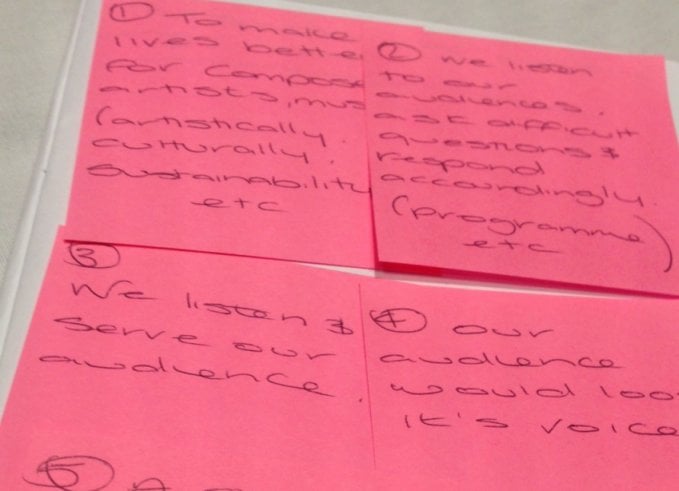
Learning from the artists
Tired of the same old conversations about audience development, Victoria Johnson has decided to shake things up.
When writing about audience development in the context of art organisations, the first question that springs to mind is whether there is anything left to say. Personally, the prospect of another workshop, seminar or even the very words ‘audience development’ makes me sigh. It isn’t that I’m bored of discussing this topic − in fact it is the very opposite. Audiences and the development of them is at the forefront of my mind and that of my colleagues and peers. Yet the all too familiar approaches, methodologies and attitudes can be frustrating.
As a sector, audience development has become our mantra. And rightly so. We work tirelessly to implement our strategies, capture engagement and to understand our audiences. We trial and test, use metrics to measure, data to drive, share with our teams and give presentations at seminars. And with the best intentions we talk about impact and sharing our findings (generally our more successful findings, the ones we are comfortable to share).
Concentrating on organisational objectives, aims and needs, rather than thinking about audiences from a wider more creative perspective, will inhibit our learning
And then before we know it, the cycle of audience development starts again. Are we missing something? What about the practitioners, artists and creatives – the ones developing the work that is connecting with audiences? The ones free from an institutional mindset, from the seminars and the endless cyclical process. What do they know, think, feel and do about audience development? What can we learn from them?
At Sound and Music we have been asking these very questions. The responses have been varied beyond our expectations, showing an ongoing curiosity and questioning nature from practitioners about what this mystery phrase really means. Yet too often the reliance on arts organisations for the answers is the overriding one. There is an assumption that we are the keepers of this knowledge and that once we have the answers we will tell them what to do.
This ‘top-down’ thinking is limiting. Concentrating on organisational objectives, aims and needs, rather than thinking about audiences from a wider more creative perspective, will inhibit our learning. With ever-changing audience drivers, attitudes, economic challenges and cultural consumption, this work will never be complete − and nor should it be. Grassroots practitioners are the key. We know this by asking and listening to them. Through our ongoing work, we devised our audience development smorgasbord – an opportunity to get practioners together to talk about their needs, challenges and successes. They spoke, we listened and we realised that we had a lot to learn. Our conclusion was that audience development is a conversation, not an end-point. Let’s not wait until we are ready to share our knowledge, until we are comfortable to talk to our practitioners. Let’s not worry about having all the answers and let’s not waste time. But instead let’s learn alongside each other now.
Our newly designed programme Audience Labs was devised to do just that. It is an initiative offering the opportunity for multiple projects to test ways of growing and diversifying audiences for new music. We have invited six lab members to develop, trial, explore and experiment with new ideas to understand and grow audiences. Together, we will challenge how audiences are engaged with and find new ways of creating life-changing experiences for audiences through music.
Our members have already identified new audiences to connect with. Sarah Nicolls’ ‘Moments of Weightlessness’ will be targeting and talking directly to mothers, a network she feels is neglected in new music. Sarah is inviting parents in areas where she is touring to take part in the conversation and contribute to the piece, as well as being the key audience. As a mother and a practitioner, Sarah knows how to engage with and develop this audience – we do not have that knowledge and will be learning from her experience.
Neon Dance, another lab member, will be testing the development of audiences across genres, through its first full-length touring work, combining dancers, multi-instrumentalists, visual artists and fashion designers. The question is whether there is a sustainable audience for this type of practice. By working alongside Neon Dance we will test this assumption with a new music audience and it will have access to our networks.
Over the course of the programme we will be introducing and exploring new models and methodology for capturing data, while providing an environment to share findings with each other and across the wider sector, be they successful or not, in an effort to strengthen our collective understanding of new music audiences. Starting this autumn, and through 2016, these six projects will run simultaneously, alongside our ongoing work in this area. I am thrilled to be exploring a creative, challenging and innovative approach to audience development and am looking forward to learning from our practitioners, listening to their experiences and developing my understanding.
To be opening up this opportunity to individuals and organisations, working on creative projects from any sector or innovative background feels new, fresh and exhilarating. So is there anything else to say about audience development in the arts? I guess so. But let’s not ask ourselves. Let’s ask the practitioners – we might just learn something.
Victoria Johnson is Head of Digital, Marketing and Communications at Sound and Music.
www.soundandmusic.org
Join the Discussion
You must be logged in to post a comment.